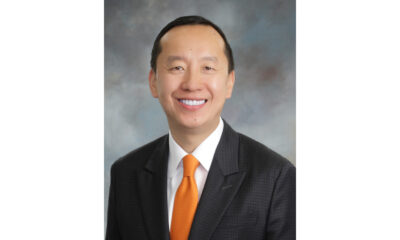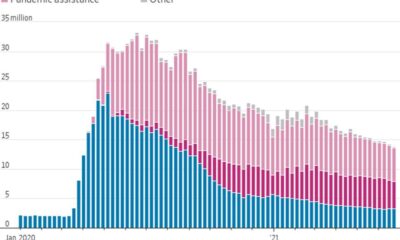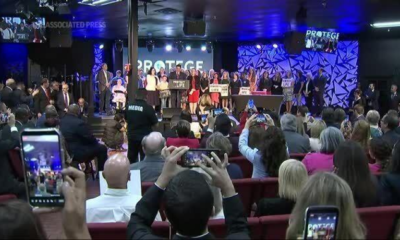Featured
The Top Richest Women In The World 2022 – Forbes

A
mong the 2,668 billionaires on this year’s Forbes list, there are few women: just 327, down from 328 last year. In all, these 327 women (including those who share their fortune with their spouse, child or sibling) are worth a collective $1.56 trillion, up from $1.53 trillion last year.
The majority of these ultra-rich women—226— inherited their wealth, including the world’s three richest women: L’Oréal heiress Francoise Bettencourt Meyers, Walmart heiress Alice Walton and Julia Koch, who inherited a stake in Koch Industries when her husband, David Koch, died in 2019. This year’s richest new woman billionaire is also an heir: Czechia’s Renata Kellnerova and her four children inherited an estimated $16.6 billion after her husband, Petr Kellner, died in a helicopter crash in March 2021.
One hundred and one women on this year’s World’s Billionaires list are self-made–meaning they founded or cofounded a company or established their own fortune, as opposed to inheriting it–including roofing supply entrepreneur Diane Hendricks, Gap cofounder Doris Fisher and British online gambling entrepreneur Denise Coates.
Notable newcomers this year include Rihanna, whose beauty empire makes her Barbados’ first billionaire; Melanie Perkins, the 34-year-old cofounder of design startup Canva; and Melinda French Gates, who’s being listed as a billionaire in her own right following her divorce from Bill Gates in mid 2021.
The U.S. has the highest number of female billionaires in the world, with 90, followed by China (63, including 11 from Hong Kong) and Germany (35).
Net worths are as of March 11, 2022
Bettencourt Meyers is the richest woman on the planet for the second year running. She’s the granddaughter of the founder of beauty giant L’Oréal and first appeared on the World’s Billionaires List in 2018, following the death of her mother, Liliane Bettencourt, then the world’s wealthiest woman.
The daughter of Walmart founder Sam Walton, Alice Walton’s fortune is up by an estimated $3.5 billion over the past year thanks to rising Walmart stock. She was the world’s richest woman in 2020, but lost her spot to Bettencourt Meyers.3.
Julia Koch, the widow of conservative donor and philanthropist David Koch, and her children own a 42% stake in Koch Industries, the second-largest private company in the U.S. David’s older brother, Charles Koch, is chairman and also owns a 42% stake.
Since divorcing Amazon founder Jeff Bezos in 2019, Scott has become one of the most prolific philanthropists in history. She’s donated $12.5 billion to more than 1,250 organizations in less than two years.
Mars inherited an estimated one-third of Mars Incorporated, the candy and pet food conglomerate behind M&M’s and brands like IAMS and Pedigree. The company was founded by her grandfather, Frank C. Mars, in 1911.
Rinehart chairs Australian mining and agriculture company Hancock Prospecting Group, which was founded by her father Lang Hancock (d. 1992). For years, she has been embroiled in a court battle against her adult children over a family trust, which will continue until at least next year; a judge reportedly delayed their next court date to 2023.
The widow of Republican kingmaker and casino magnate Sheldon Adelson, Miriam now owns her late-husband’s nearly 50% stake in Las Vegas Sands following his death in early 2021. Two months after Adelson died, the company agreed to sell its marquee assets in Las Vegas, including the Venetian Resort and the Sands Expo and Convention Center, for $6.25 billion in an effort to focus on the Asia market.
Susanne Klatten owns about 19% of German automaker BMW, which she inherited from her mother Johanna Quandt and father Herbert Quandt, the industrialist who is credited with rescuing BMW from bankruptcy in 1959. Klatten also owns chemicals company Altana.
Fontbona is the widow of Chilean magnate Andrónico Luksic, who died of cancer in 2005 after building a fortune in mining and beverages. She and her family own copper mines in Chile through Antofagasta Plc, which trades on the London Stock Exchange. They also own a majority stake in Quiñenco, a publicly-traded Chilean conglomerate that does business in banking, beer and manufacturing.
Abigail Johnson has been CEO of Fidelity Investments since 2014 after taking over for her father Ned Johnson III, who died in March. She owns an estimated 24.5% stake in the firm, which has $4.2 trillion in managed assets and was founded by her grandfather in 1946.
Featured
India and Pakistan Agree to Ceasefire Amid Rising Tensions

On May 10, 2025, the world breathed a cautious sigh of relief as India and Pakistan, two nuclear-armed neighbors with a long history of hostility, agreed to a ceasefire following a series of escalations that threatened to ignite a full-scale war in South Asia.
The Trigger: A Devastating Attack
The conflict reignited after a tragic terrorist attack in the Indian-administered region of Kashmir left 26 civilians dead. The assault, which targeted a busy market in the city of Srinagar, immediately raised suspicions within Indian intelligence circles, who blamed Pakistan-based militant group Jaish-e-Mohammed. India swiftly condemned the attack, calling it a “cowardly act of terror” and vowed to respond with force.
Retaliation and Escalation
Within 48 hours of the attack, India launched a series of targeted missile strikes on what it claimed were militant training camps in Pakistan-administered Kashmir. The air raids resulted in multiple casualties and further inflamed tensions between the two countries. Pakistan responded with its own military mobilization and threats of retaliation, pushing the region to the brink of war.
For days, military analysts and diplomats around the globe watched with increasing concern. Social media lit up with reports of troop movements, blackouts in border towns, and intercepted communications suggesting a possible escalation to conventional warfare. The international community, particularly the United Nations and regional allies like China and the United Arab Emirates, called for immediate de-escalation.
A Surprising Diplomatic Intervention
In a twist that caught many off-guard, former U.S. President Donald Trump stepped in as an unofficial mediator. Leveraging his prior relationships with both Indian and Pakistani leaders from his time in office, Trump initiated a series of behind-the-scenes discussions. According to insiders, the former president made multiple phone calls and engaged in shuttle diplomacy to broker peace.
Critics questioned Trump’s involvement, but even skeptics admitted that his intervention appeared to cool tempers. The talks culminated in an agreement between Indian Prime Minister Arvind Reddy and Pakistani President Ahsan Qureshi to observe a full ceasefire starting immediately.
Terms of the Ceasefire
The agreement included several key components:
- Immediate halt to all military actions along the Line of Control (LoC).
- Establishment of a joint investigation into the Kashmir attack, with representatives from both nations and neutral observers.
- Reinstatement of diplomatic backchannels that had gone cold since 2023.
- A scheduled summit in Geneva in July 2025 to discuss long-term peace frameworks and cross-border terrorism.
Indian Defense Minister Nikhil Menon confirmed the ceasefire in a televised address, stating, “While we will never tolerate terrorism, we recognize the importance of dialogue in preventing further loss of life.”
Reactions at Home and Abroad
Domestically, reactions were mixed. Indian nationalists criticized the government for not pursuing a more aggressive stance, while peace advocates praised the leadership for prioritizing diplomacy over war. In Pakistan, President Qureshi faced both praise for preventing escalation and criticism for conceding too quickly under international pressure.
Global leaders, including UN Secretary-General Antonio Guterres, applauded the ceasefire as a step in the right direction. China issued a statement urging both countries to continue working toward peaceful solutions, while Russia offered to host future peace talks.
What’s Next?
While the ceasefire has brought temporary calm, the underlying issues remain unresolved. The Kashmir region continues to be a flashpoint, and both nations harbor deep mistrust. Experts warn that without substantial policy changes and mutual agreements, future flare-ups are inevitable.
Still, the May 10 ceasefire is a reminder of the power of diplomacy—even when led by unexpected figures. Whether this truce holds or falters will depend on the upcoming Geneva summit and the political will of both nations to choose peace over provocation.
For now, South Asia watches and waits.
Featured
From Local Hustle to Global Empire: 16 Visionary Entrepreneurs Teaching Business Tips for Success

At some point in the entrepreneurial grind, every high achiever faces the same question: Is all this hustle really building the legacy I want? Scaling a brand takes more than clever marketing and social media trends—it takes mindset alignment, financial literacy, purpose-led decisions, and a story that reaches beyond borders.
The 15 leaders featured here aren’t just building businesses—they’re dropping hard-earned wisdom that can change how you grow, lead, and impact. Each one shares a tip rooted in real experience, crafted to help you build an empire that actually lasts.
This list was curated by entrepreneur and speaker Taurea Avant, who brought together this group of extraordinary changemakers to be featured in the book Elevate & Empower, launching at the Legacy Leaders Workshop happening Thursday, May 22. We thought it only made sense to share their top leadership and business-building tips in this powerful article.
LaShana West: Your business can’t grow beyond your mindset. Before you build systems, scale strategies, or chase clients, address your internal roadblocks. Healing past trauma can unlock future income. When you lead from wholeness instead of hustle, your clarity increases—and so does your cash flow.
Too many entrepreneurs try to fix external problems without addressing the internal wounds driving them. Start with your belief systems. Mindset isn’t just a buzzword—it’s the foundation your business is built on.
Nichica F. Melton, M.Ed.: Clarity kills chaos. If your calendar is packed but your results are flat, simplify. Use time-blocking to control your week and commit to no more than three top priorities a day. Overwhelm isn’t a badge of honor—it’s a sign of broken systems.
Productivity is more about discipline than doing more. Focus isn’t about having time—it’s about making intentional decisions and protecting your energy like a high-value asset.
Lisa Stringer Bailey: Pay yourself first, always. If you’re waiting until the end of the month to see what’s “left,” you’ll never create real wealth. Automate a percentage of your income into savings or investments and treat it like a non-negotiable bill.
Money mastery isn’t about big wins—it’s about consistent habits. Wealth is built in percentages, not paydays.
Dr. Dominique Carson: Your body is your most valuable business asset. Prioritize physical restoration with regular breaks, massage therapy, and movement. A burnt-out body can’t build a booming business.
Physical health and business growth go hand-in-hand. Energy, focus, and endurance all start with how well you take care of your body.
Dr. Dawn Menge: Use storytelling to simplify complex ideas. Whether you’re teaching, selling, or leading, narratives create emotional connection. People won’t remember data—but they will remember how your message made them feel.
Leaders who leverage storytelling build deeper relationships, higher trust, and longer-term loyalty. Start every message with “why this matters.”
Naomi Carrington-Hockman: Speak with clarity and confidence. Rambling loses respect. Know your key point, say it early, and reinforce it with presence. Whether on stage or in a Zoom room, your tone, timing, and takeaways define your impact.
Great communicators aren’t wordy—they’re intentional. Influence is built when your message sticks and moves people to act.
Dr. Toccara Nicole Steele: Your book should be your blueprint. Don’t stop at publishing—build products, services, and offers from your content. Every chapter holds an opportunity to create value beyond the page.
Think of your book as intellectual property, not just inspiration. Extract and expand to scale.
Shanita Crafter: Your emotional health determines your business ceiling. Set boundaries, take breaks, and get support when needed. Healthy leaders build healthy legacies.
If you’re emotionally exhausted, you’re not equipped to serve others. Build emotional recovery into your business plan.
Crystal D. Woods: Healing is a business growth strategy. Don’t ignore emotional pain just because you’re meeting professional goals. When you confront what’s hurting you, you create space for clarity, creativity, and deeper alignment.
Running from your story weakens your brand. Stand in your truth and let healing shape your leadership, not hinder it.
Dr. Obioma Martin: Self-love is a leadership strategy. When you prioritize inner peace, your decision-making sharpens, your relationships improve, and your tolerance for nonsense disappears. Lead from overflow—not depletion.
Confidence starts with how you treat yourself. Model the grace and discipline you expect from your team and clients.
Ronald Holloway: Build with people in mind, not just profit margins. When your business solves real problems and serves real needs, revenue becomes a byproduct of impact.
Purpose-driven ventures create sustainable income and community trust. Listen to what your audience truly needs—not just what’s trending.
Taurea Avant: Your book should work harder than you do. Use it to secure media, land speaking gigs, build your list, and attract aligned clients. If your book isn’t getting you business, it’s not being leveraged correctly.
Authors don’t need more hustle—they need more strategy. Your message is your magnet. Use it.
Dr. Lena Payton Webb: Vulnerability isn’t weakness—it’s brand power. When you own your story, you create resonance. Curate your narrative with intention and share it consistently across platforms.
Authentic storytelling builds brand authority. You become the guide your clients are looking for when you show them you’ve walked the path.
Teri Thompson: Invest in the next generation. Teaching youth entrepreneurship plants seeds that grow into scalable, sustainable impact. Your legacy is measured by how many leaders you help raise.
If you mentor young entrepreneurs, you multiply your influence. Build a legacy that outlives you by pouring into those coming behind you.
Ernee Peppers: Don’t just speak—perform. Stage presence can 10X your perceived value. Walk in like the deal is already closed. Confidence sells before you even open your mouth.
Public speaking is a business development tool. The better you own the mic, the more doors you open.
Daria Rosen: Build your business to match your life—not the other way around. Create routines, products, and timelines that honor your season of life, especially during hormonal or emotional transitions.
Your business should serve your health, not sabotage it. Structure creates freedom when aligned with who you are now.
Success isn’t about doing more—it’s about doing what actually matters. These 16 leaders aren’t giving fluff. They’re handing you the same insights they’ve used to build powerful, profitable, purpose-filled businesses.
Want more of their wisdom in the room with you? Join them at the Legacy Leaders Workshop in Dubai, where they’ll dive deeper into the tools, frameworks, and mindset strategies that are shaping the next generation of impactful leaders.
All attendees will receive a FREE copy of the book, Elevate & Empower—a playbook of tips, frameworks, and legacy-building strategies.
It’s time to stop grinding and start growing.
Lock in your spot at www.LegacyLeadersWorkshop.com
Grab your merch and books at www.AuthorAllstars.com/shop
This is your moment. Own it. Build it. Lead it.
Featured
China’s Strategic Clapback: How Luxury Brand Exposure Became an Economic Retaliation Tool
China claps back on the United States

In the wake of escalating tariff tensions between the United States and China, a new form of economic retaliation has emerged—one that doesn’t involve additional taxes, embargoes, or diplomatic statements. Instead, China has turned to social media and transparency as its sharpest tools. What began as viral content on platforms like Douyin (China’s version of TikTok) has become a calculated, highly effective campaign revealing the true cost structures and manufacturing origins of Western luxury products.
The results? Consumer backlash, brand skepticism, and a major shake-up in global perceptions of luxury.
The Backdrop: U.S. Tariffs and China’s Silent Response
The U.S. recently imposed a new wave of tariffs targeting Chinese imports—ranging from electric vehicles to critical components used in renewable energy and technology sectors. Instead of responding through traditional government channels, China opted for a culturally resonant and strategically disruptive response: peeling back the curtain on the luxury goods Americans hold dear.
Through viral videos, Chinese factory workers, influencers, and content creators have started showcasing the real production costs and assembly processes behind designer items sold by global brands like Hermès, Gucci, Chanel, and others. The content, often presented in side-by-side comparisons of production cost versus retail price, has gone viral on both Douyin and TikTok, resonating with a global audience of skeptical, budget-conscious consumers.
Revealing the Margins: From $100 Manufacturing to $10,000 Price Tags
One widely shared video displayed the step-by-step manufacturing of a Hermès-inspired handbag, noting that its production cost was approximately $120 USD. The retail equivalent of the same bag? Upwards of $12,000. Similar videos have shown luxury sneakers being produced for under $30, designer belts for less than $20, and branded jewelry created from base materials available at a fraction of retail prices.
The implications are far-reaching. For decades, luxury brands have justified their price points through the appeal of exclusivity, craftsmanship, and brand legacy. However, this transparency campaign is effectively undercutting that narrative by focusing the spotlight on the reality of outsourced labor and inflated margins.
Psychological Warfare Through Transparency
While the move may appear grassroots, industry analysts suggest this surge of transparency is anything but random. It comes at a time when the Chinese government is tightening its internal regulations on displays of wealth and pushing for greater domestic modesty in personal consumption. At the same time, this exposure allows China to assert quiet leverage in the ongoing trade war.
By revealing that many luxury products sold in the West are, in fact, manufactured in China—often in the very factories now subject to tariffs—China is flipping the power dynamic. It’s a reminder to Western consumers and lawmakers alike: China is not merely a source of low-cost goods—it is also the backbone of many of the West’s most celebrated brands.
This form of “soft retaliation” is strikingly effective. Rather than targeting governments, it targets perceptions. And in an era where brand reputation can swing markets, perception is everything.
Consumer Reaction: Disillusionment and Demand for Accountability
As these revelations gain traction, social media has become a hotbed of discussion. Consumers, especially younger generations, are questioning the true value of the luxury items they once saved up for. Comments across platforms express a common theme: disillusionment.
Many are calling for more ethical transparency in pricing models and supply chain management. The exposure has also triggered interest in alternative luxury, such as direct-to-consumer models and brands that prioritize authenticity and fair labor practices.
This shift presents both a challenge and an opportunity for global luxury brands. The challenge: rebuilding consumer trust. The opportunity: reintroducing their value in a way that withstands scrutiny—not just from regulators, but from an increasingly informed customer base.
Broader Implications for the Luxury Market
The luxury industry is built not only on materials and labor, but on perception. Prestige, quality, and exclusivity are carefully curated attributes that command high margins. The current wave of manufacturing transparency challenges the very foundation of that perception.
As global consumers become more aware of product sourcing and true cost structures, brands will be forced to adapt. This may lead to:
- A deeper investment in domestic manufacturing to regain trust
- Greater openness about pricing models and ethical practices
- Stronger marketing around craftsmanship and quality assurance
At the same time, this may also accelerate the decline of blind brand loyalty. Consumers are already turning toward values-based shopping, and this transparency push could expedite that shift.
Conclusion: Economic Strategy Reimagined
China’s decision to allow—or at least not suppress—the mass exposure of U.S. luxury brands’ production realities is a masterclass in modern economic strategy. It sidesteps direct confrontation and instead wields cultural and consumer influence as tools of power. Rather than imposing tariffs of its own, China has placed the burden of response on Western companies and the consumers they serve.
As the global economy becomes more interconnected and more visible, traditional forms of economic retaliation may give way to perception-based strategies. In this case, China has sent a message loud and clear: If you’re going to tax our exports, don’t be surprised when we reveal what your imports are really made of.
-

 Featured9 months ago
Featured9 months ago20 Entrepreneurs to Watch Closeout 2024
-

 Innovation1 year ago
Innovation1 year agoLeo Horacio: A Successful Entrepreneur in the Ecommerce and Online Sales Industry
-

 Innovation11 months ago
Innovation11 months agoInnovators in Social-Emotional Learning: Dr. Myava Clark and Chris Clark Jr.
-

 Latest10 months ago
Latest10 months agoCharles zhang recognized by forbes as #1 on michigan’s 2022 best in state wealth advisor list
-

 Lifestyle1 year ago
Lifestyle1 year agoPhillip Austin brings outlaw country to General Duffy’s stage – The Bulletin
-

 Music12 months ago
Music12 months agoArtist Deydee Signs $350,000 Contract with Rueda Empire LLC
-

 Small Business10 months ago
Small Business10 months agoSmall Business Labor Shortage – Forbes
-

 Latest9 months ago
Latest9 months agoFlorida Gov DeSantis signs 15-week abortion ban | Latest News





